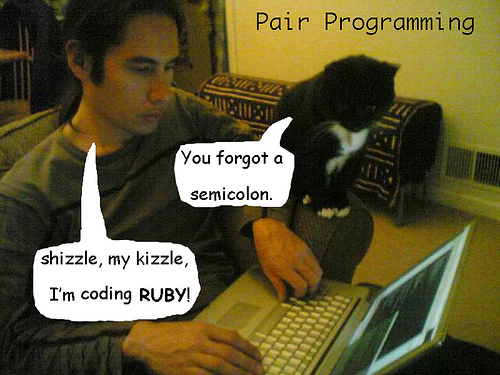


 Some rights reserved by Dav
Some rights reserved by Dav
Since I wrote the interview with Farhan of Xtreme Labs on Pair Programming, I have exchanged a number of emails on pair programming & developer productivity with some of Canada’s best developers. Most of them are pure gold that I am posting raw and unedited.
———————————————————————————————
“The main thing we like to stress on development is Test Driven development. We just find that it both ensures all the code is well tested, but also guides the architecture in a way that really improves maintainability. We use pairing in our interview process and also like to pair for the first couple of weeks to get developers up to speed, but after that we tend to split up work for the day and then attack separately.” – Jesse Miller, CEO of attachments.me
———————————————————————————————
“Whether to use pair programming or alone model really depends on the team personality and the kind of culture the leaders want to shape up. Some people do work better alone, and some prefer more teamwork.
Personally, I usually value teamwork more than individual results. At the end of the day, individual work will have to be integrated to form the end product, which is what really matters. There are too many examples where people think they got great ideas, but end up in epic failure during implementation. It is a result of not doing deep enough design validation. Coding alone is definitely more effective when you got the design details flushed out. Personally, when I am coding alone, I still ask for 2nd or 3rd opinions on a day to day basis. It forces me to think through the design again and again, which helps to refine my idea further. It is all about attitude. Never believe that you got it right until see the end product.
Another interesting thing is “pair troubleshooting” is more effective. When you’re trying to debug in an extremely stressed environment, it is always good to have some mental support and another pair of eyes.” – John Yuen, heads up dev for Fixmo
———————————————————————————————
“I think that pair programming does actually increase productivity, in most cases, and there are two reasons for this:
1. It keeps programmers from doing other things:private email, browsing, day dreaming, etc. I doubt that the average programmer actually spends even 50% of their time doing their job. If you can hire two developers, and get the work of one full programmer out of them, then I think, in a lot of cases, that would be an improvement. However, you could get almost the same result by pairing each
programmer with their own full-time low-cost supervisor who sits beside them to make sure that they’re actually working. This would be a lot cheaper and almost as productive, but the developers would find it insulting. This isn’t always the case of course; there are certainly many self-motivated, disciplined, highly-focused and productive developers who don’t need supervision.
2. Studies have shown that programmer productivity is limited, not by the time it takes developers to write code, but by the time it takes them to detect and correct errors. The limiting metric isn’t lines-of-code-per-hour, but rather, errors-debugged-per-hour. This is why Java is more productive than C++, despite the two languages being of similar expressive levels, Java’s runtime exceptions make it quicker to detect and recover from many times of errors, and garbage collection completely eliminates many other types. This is where pair-programming comes into play, if someone looking over your shoulder can spot an error as soon as it’s created, then that can lead to a lot of time savings. Maybe it would have only taken you two minutes longer to detect and fix a particular bug, but then gain, maybe it would have taken a week. Your partner wouldn’t need to early-detect very many problems in order to justify the overhead.
Maybe one developer sitting in a control booth, like a security guard, monitoring the work of half-a-dozen developers all at once, would be a good compromise between pair and pair-less programming.
Yes, it’s true that ACM programming contests are performed on only one computer, but you rarely have more than one person working on the same problem. While one is typing in and debugging their solution, the other programmers are working with pencil and paper solving their own problems (with occasional help from their team mates as required).
People are more important than any process or any tool. The best process is to hire the best people and a better developer is the best tool.
I half agree with what the original article says about hero developers. They say that you don’t need them, and that you’re better off with the a consistently productive 9-to-5’er. I think they’re
confusing heroes with heroics. I think that you do need heroes, but you don’t need the heroics of pulling all-nighters. Instead, you need the heroics of consistently creative and proactive problem solving which keeps you efficient, effective, and ahead of the game, day in, and day out. Effort should not be confused with results. I think they have the wrong definition of heroics, which leads to the wrong definition for heroes.” – Kevin Greer, Framework Lead at Redknee.
———————————————————————————————
Point #2 from Kevin Greer’s comments is widely unappreciated. Most people judge productivity by features and the “to do” list – when in reality it is not the to do list of features that usually makes projects late, it is the killer game of bug squashing, especially as you get to the stressful end of project delivery. Processes that reduce the upfront bug rate or increase the bug solving rate, even at the expense of adding features pay off quickly. This is were pair programming, test driven development, code reviews, architecture chats, etc all come into play. And why “pair troubleshooting” or other tools to debug problems fast are important. And also, use the damn debugger, it is there to make solving bugs faster.
I’d love to hear from more of the programming community in the comments. Tell us how you supersize your development productivity.








